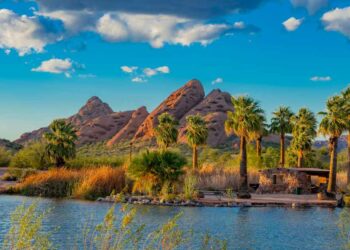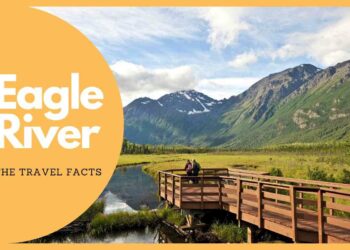Japanese hot springs are also called Onsen, which is quite famous around the world. There are more than 27,000 hot springs in Japan, and that is because of its plentiful volcanic activities throughout the country. Additionally, 47% of the Japanese hot springs have temperatures above 42 degrees Celsius. There are about 3,085 hot spring resorts in Japan that are provided with accommodation facilities. The majority of the Japanese hot spring resorts are distributed along volcanic belts, so there is no scarcity of heat sources for hot springs. The rainy season, typhoons, and snowfall play a vital role in bringing huge amounts of water resources to the Japanese archipelago. There is also an abundance of origins of hot spring water. These are some reasons that Japan is one of the world’s principal hot spring countries.
Onsen water is geothermally heated underneath the ground and rises to the surface bubbling hot. Because of this abundance of hot spring resources, the Japanese people have nurtured an authentic and special culture of bathing and healing in Japanese hot springs since ancient times. Scientifically it is proven that a therapeutic bath in hot springs can treat certain medical conditions and promote health benefits. The hot spring bath causes stimulation and penetration of various minerals and other elements that promote hormone secretion. It is also proven to prevent aging. It is said that 90 percent of diseases and aging are caused by free radicals. Free radicals are the oxidizing substances that cause corrosion to the cell membrane which further continues to damage the DNA and become cancerous. And since the hot spring water possesses restoration properties it is called the “waters of youth”.
Table of Contents
Hot spring resorts in Japan
Kusatsu Onsen
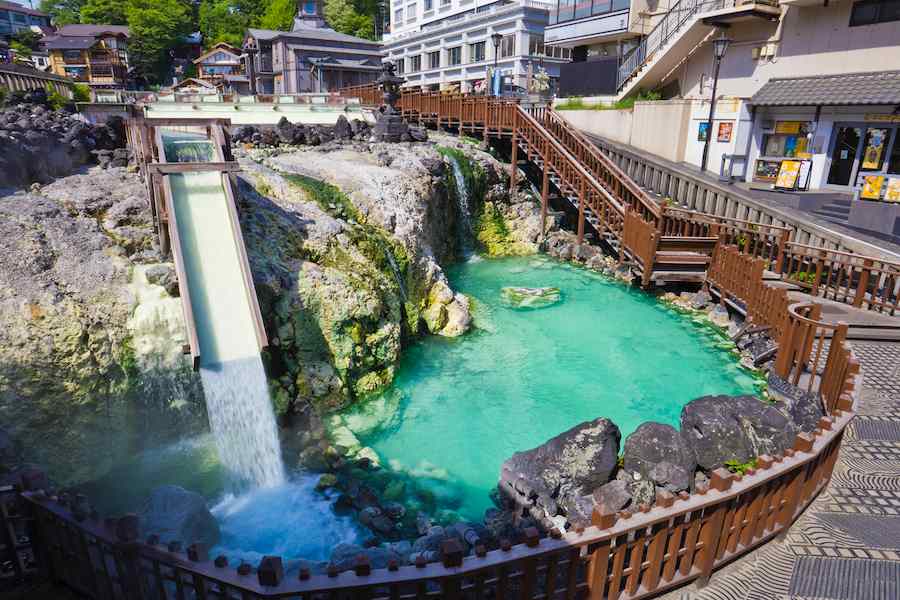
This Japanese hot spring is located in Gunma Prefecture. It is situated at an altitude of 1200 meters above sea level. The water of this Japanese hot spring is sourced from Mount Kusatsu-Shirane which is located nearby. The sourced water is quite acidic with a pH of around 2, so an acid neutralization facility takes place to maintain the water quality that is suitable for fish to inhabit the rivers. The water at Kusatsu Onsen is comparatively much warmer than the rest of the Onsen listed here. And to cool it down a special stirring procedure (yumomi) is performed instead of adding cold water. It is because the addition of cold water would risk the potential of mineral contents in the water. This Japanese hot spring boasts an incredible forest view that plays a vital role in increasing one’s vibration. A bath in this Japanese hot tub is said to be able to prevent and cure any sickness except lovesickness. Apart from a hot bath if you are looking forward to doing something more, then you might also consider paying a visit to Mt. Shirane. Mt. Shirane offers hiking trails during spring and summer, and skiing during winter. You can even experience Kusatsu’s beautiful Snow and Spa Resort if you visit during the months of early December to mid-April. All these amazing outdoor adventures along with the hot spring makes it the #1 hot spring resort in Japan in the past two years as voted by the Travel companies in Japan.
Beppu Onsen
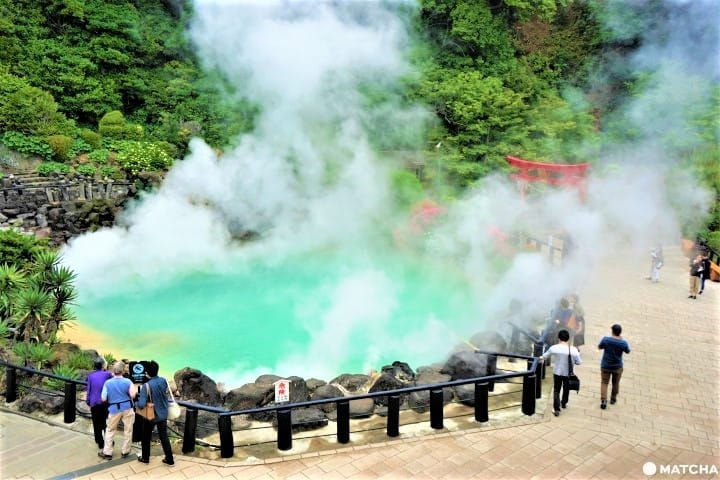
Beppu, the hot spring capital of Japan is one of Japan’s iconic and famous hot spring regions. In the city of Beppu, you can spot hundreds of hot springs with unique atmospheres, which are mainly distributed in eight areas, thus, Beppu City is also well-known as Beppu Hatto (which means 8 springs in Japanese). Beppu is built of a cluster of eight onsen areas. However, it’s a bit of a hassle since you’ll have to trek to get there, but it’s worth a visit. It has numerous bath options including mud, steam, and even sand baths. Sand Bath on Shoningahama beach is the most preferred bath among tourists. To experience this type of bath one has to be submerged in volcanically heated sand. It overstates the highest number of Japanese hot spring locations as well as the maximum annual yield of hot spring water in the country. You can easily reach this location by taking a 1 hour 40 mins flight from Haneda Airport to Oita Airport, then take a 45-50 mins bus ride to the Beppu Kitahama bus stop. However, if you have sufficient time and a tight budget you might consider multiple trains from Tokyo Station to Beppu Station i.e., a 5 hours long train ride by shinkansen from Tokyo Station. Followed by the Nozomi Shinkansen to Kokura Station, then finally shift to the Sonic limited express to reach the Beppu Station.
Fuji Kawaguchiko Onsen
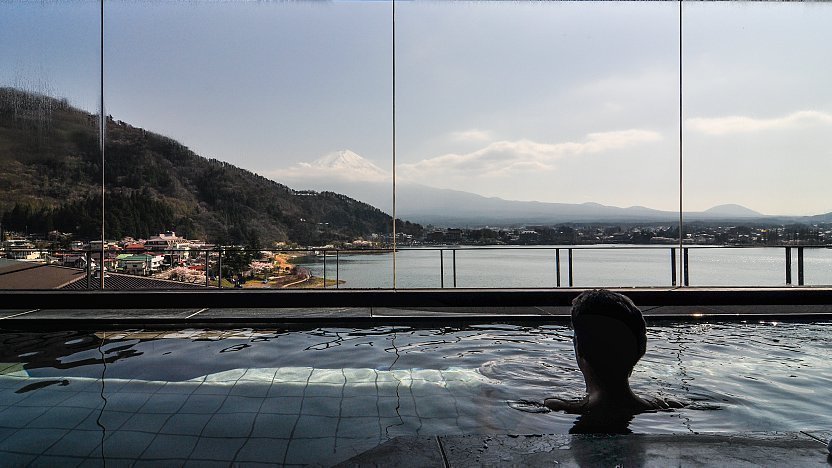
This Japanese hot spring is the second largest lake out of the five Fuji lakes. It is a place that offers serene beauty as it possesses a jaw-dropping and magnificent view of Japan’s very own and worldwide famous Mt. Fuji. It is located at the bottom of the iconic Mount Fuji. Numerous bath houses and ryokan offer not only indoor but also outdoor bathing. The region is most scenic during the spring cherry blossom season and autumn Koyo, or leaf viewing, season. Besides enjoying this Japanese hot tub you can visit the beautiful flower garden and also enjoy the delicious meals offered.
Yufuin Onsen
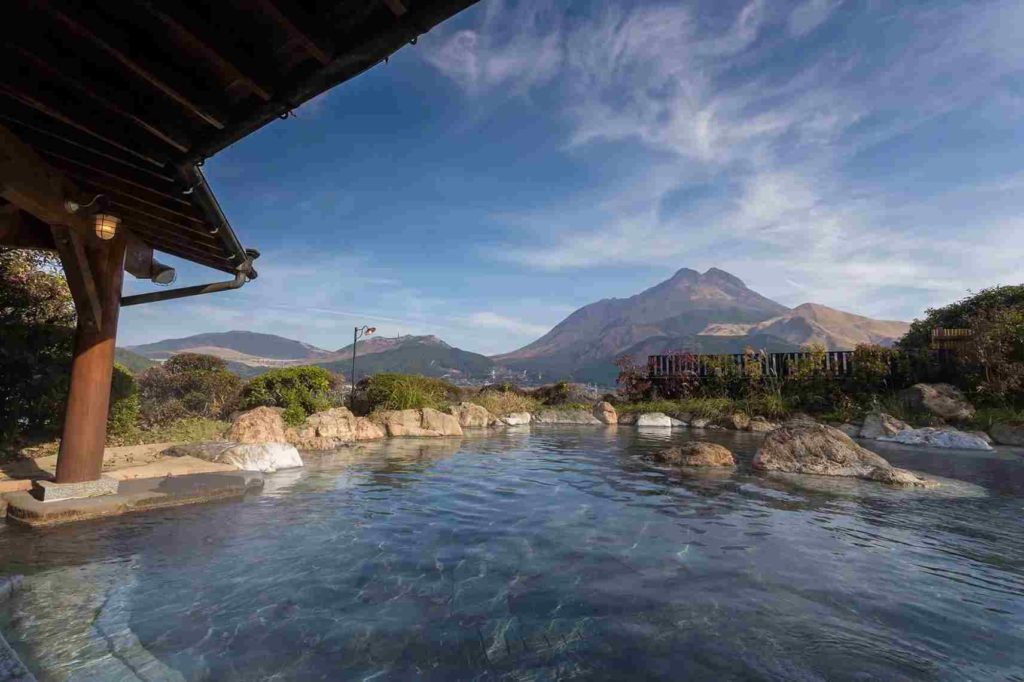
This is one of the most famous hot spring resorts in Japan in Oita Prefecture. It is not a typical crowded hot spring resort as it is located in a small valley surrounded by mountains. So, it is a considerably ideal Onsen for the people out there who seek a peaceful and quiet atmosphere. There are many ryokans that are scattered nearby in the local area. This Japanese hot spring is rich with nature and fields that extend throughout the valley. During spring, the cherry blossoms and mustard flowers are quite a sight! And likewise, rice fields are a lush green in the summer and ginkgo and maple trees that change their colours to vibrant reds and yellows in autumn, and white snow wraps the whole town in winter. Apart from all this scenic beauty, one can also enjoy numerous cafes, boutiques and art museums around the place. This Japanese hot spring features a stunning view of Mount Yufu. It is certainly the area to click your most Instagram-worthy pictures. Lastly, it is the ideal location to enjoy traditional onsens and the beauty of coexisting with nature in Japan.
Kinosaki Onsen
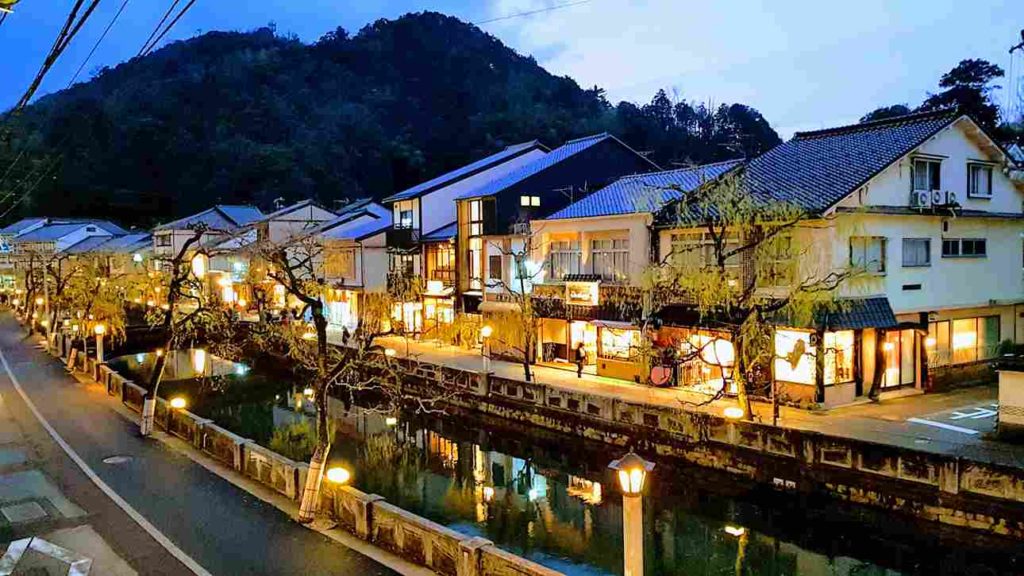
Understanding traditional onsen culture can sometimes be intimidating for non-Japanese tourists, where signboards aren’t always translated into other languages and have no-tattoo policies. This means that the hot springs aren’t open to everyone. But, you would be glad to know that this Japanese hot spring openly accepts people with tattoos. And for this sole reason out of many hot springs in Kinosaki, the most popular are the seven public hot springs. The onsens are rich in minerals that are claimed to help with digestive issues, nerve and muscular pain, and even bruises. Each bathhouse has unique features, and one can try them all. The town aims to make authentic experiences that are accessible for everyone. Besides these Japanese hot tubs, there’s an abundance of activities to participate in the area including guided zazen meditations to green tea picking. Additionally, there are also English-speaking guides available who will help you through the paths and guidelines.
Noboribetsu Onsen
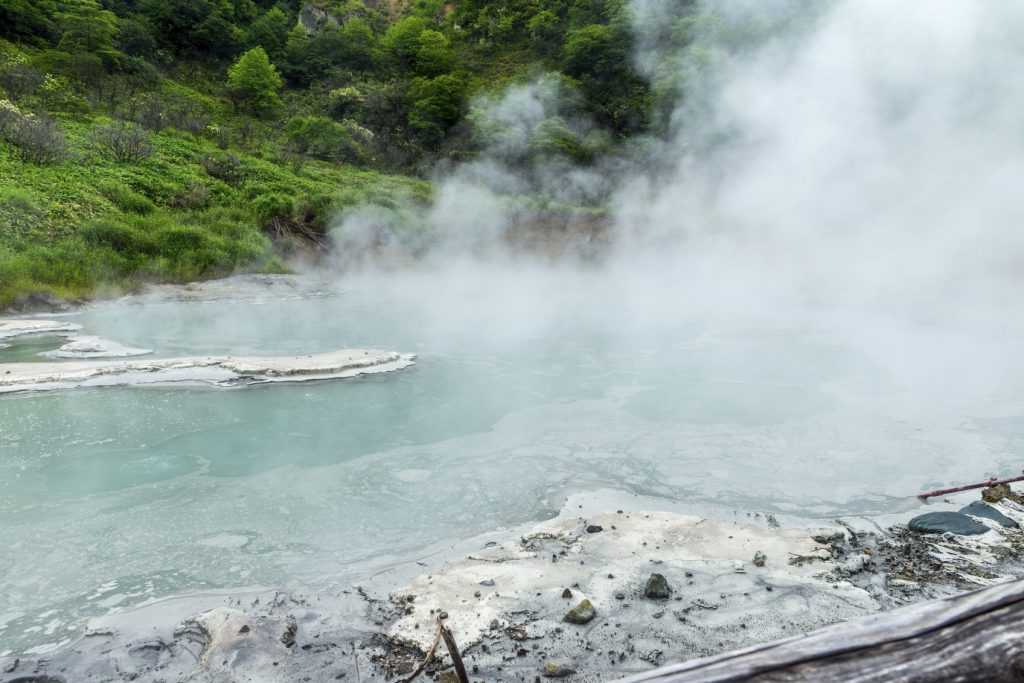
The Noboribetsu Onsen is one of the renowned hot spring resorts in Japan which is filled with numerous large-sized ryokan and hotels with onsens. The “Noboribetsu” word comes from the Ainu word “Nupurupetsu” which means “The white muddy river” or “Thick coloured river” which depicts the abundant flow of hot springs that changed the colour of the river. This Japanese hot spring is located in Hokkaido. And there is no better way to warm up yourself in the bubbling hot Onsen during Hokkaido’s cold weather. The Noboribetsu Onsen offers up to eleven varieties of thermal waters that are known for many benefits that are proven to be very good for the human body. Moreover, there are many hotels and ryokan that open their baths during the daytime for the tourist or people to enjoy, in case they don’t want to stay in a hotel. It is the ideal place to simply sit back, relax and enjoy the peaceful hours.
Hakone Onsen
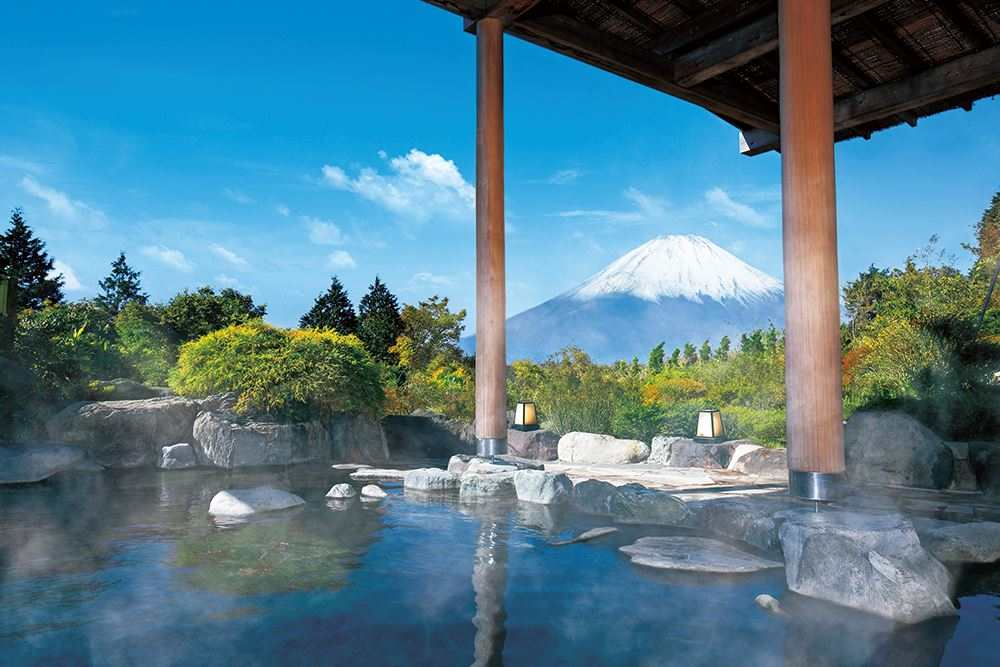
Hakone is exceptional on this list of top Onsen for its absolute variety. Hakone is close to Lake Ashi. It offers numerous hot tubs to its visitors and each of them has its charm. The town also has various onsen theme parks, and luxurious ryokan with private exclusive hinoki baths to experience the best. The Yunessun spa resort is an absolute attraction since it provides features like coffee and wine baths, hot spring water slides and cave pools to explore. Yunessun features coed baths that you can get into wearing a swimsuit and by this, you don’t have to be isolated from your family and friends during your visit. If you are looking forward to something extra than just serene you might consider checking Hakone Yuro. This hot spring resort in Japan is surrounded by forests and provides communal facilities. It has 19 private Onsen rooms which you can book if you want a private open-air bath experience. Among numerous hotels and ryokan to choose from, we recommend Tenzan and Yunessun Onsen which is located inside a cave. It not only offers various baths such as coffee, tea and wine baths but also permits swimwear for its self-conscious visitors.
Dogo Onsen
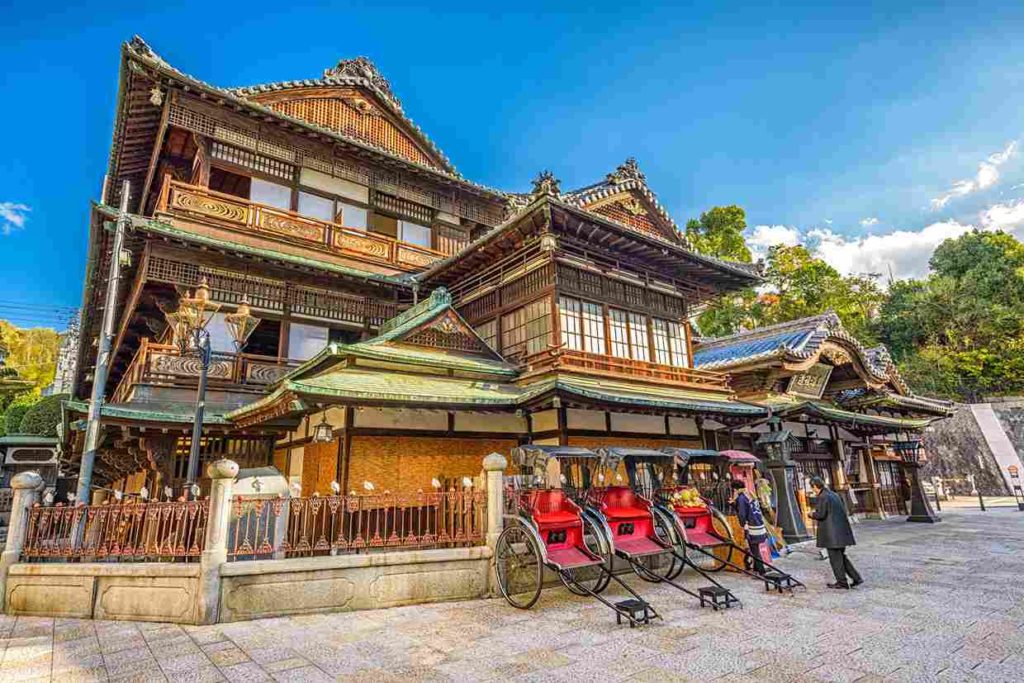
Dogo is located on Shikoku island and is well-known as one of the oldest onsen in Japan. It has 3,000 years of history and is even rumoured to have served royals in the past. It features a large magnificent, castle-like bathhouse and many ryokans. This is an ideal hot spring resort in Japan to immerse yourselves in the country’s history, culture and traditions. Besides, Dogo Onsen public bathhouse is worth a visit too! This bathhouse has been said to inspire many elements of the Studio Ghibli film Spirited Away. So for fans out there who like the film set, it’s an opportunity to check out this cozy bathhouse and experience it for yourself.
Kurokawa Onsen
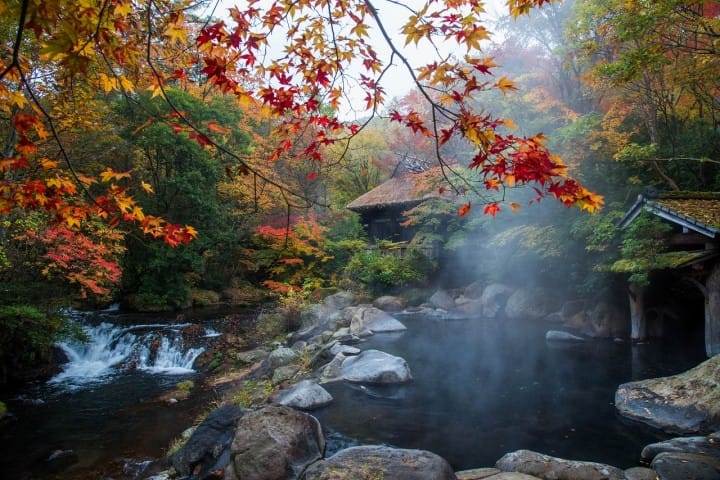
It is the most picturesque hot spring resort in Japan. This town in Kyushu offers approximately 30 Onsen baths for visitors to submerge in. It is not only known for its attractive town but also for its unique and giant outdoor baths (rotenburo). Some of these baths are located right beside a gushing river boasting a beautiful scenic view. Kurokawa Onsen has a history lasting at least 300 years, with tales of feudal lords stopping by to rest during their journeys between cities. Today, the town still radiates the spellbinding spirit of its former days with shops and ryokans grouped across the river that are lit up each night with beautiful glowing lanterns.
This sums up the list of the 9 best hot springs resorts in Japan. With this huge variety of Onsen available, you’d be spoilt to choose. Tingling to try out Japan’s magnificent hot spring now? You surely won’t be disappointed!







